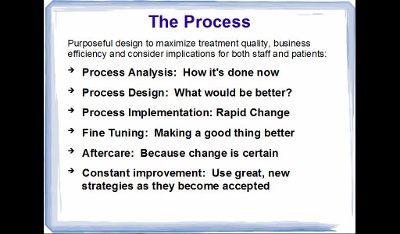-
- 09
Aug - (0)
Approaching Electronic Health Record Implementation
“Implementing an EHR may very well be the single largest project you will ever be a part of in your career”.
Believe it. I would add that if your organization’s EHR implementation wasn’t effective, the solution is to take a different look at how it’s done and plan to optimize what you have…read on.
 The statement above came from an announcement of a NIATx presentation I received recently. In the past, the biggest problem standing in the way of effectively and completely implementing an Electronic Health Record (EHR) for Mental Health and Substance Abuse Treatment was a reluctance to spend valuable professionals’ time and energy that’s required to be successful and make the software do what you want it to do. This could apply to any system, really, from a single provider to a large organization with hundreds of users.
The statement above came from an announcement of a NIATx presentation I received recently. In the past, the biggest problem standing in the way of effectively and completely implementing an Electronic Health Record (EHR) for Mental Health and Substance Abuse Treatment was a reluctance to spend valuable professionals’ time and energy that’s required to be successful and make the software do what you want it to do. This could apply to any system, really, from a single provider to a large organization with hundreds of users.There are a number of approaches to getting the same thing done that all revolve around the same thing: Make the software do what the organization needs. I find that if we look at a few elements at a time, and note people who might be appropriate to head up that aspect of the implementation, we’re more likely to have a successful effort than if we try to blast everything out at once, disrupting the work and lives of every professional and treatment of every consumer.
Here are a few ideas to spur some thought, starting with what I think is most important, and then a couple different aspects of the broader view from experts in getting jobs done.
McLeod’s Method: A call this “my” method, simply because it’s part of the system I use.
 Over the years I’ve picked up a bundle of experience and wisdom from so many sources it would be silly for me to go back and re-construct history….so I call it “mine”. There are many other factors to consider, so I also pay attention to the points attended to by industry leaders in their views below…and more. First, address these bullet points and look into elements like “Rapid-Cycle Change”.
Over the years I’ve picked up a bundle of experience and wisdom from so many sources it would be silly for me to go back and re-construct history….so I call it “mine”. There are many other factors to consider, so I also pay attention to the points attended to by industry leaders in their views below…and more. First, address these bullet points and look into elements like “Rapid-Cycle Change”. Malcomb Baldridge The National Institute of Standards and Technology (NIST) Baldridge Award is a government award for excellence that includes criteria for healthcare for both profit and not for profit organizations. The reason to participate is, according to David Spong, former Boeing executive and winner of the award, is that it improves performance. For professionals, that means not only “production” (seeing more consumers), but improving consumer care for better outcomes. The Baldridge Criteria focus on several elements of importance and help health care organizations achieve and sustain the highest national levels of • Patient safety and loyalty • Health care outcomes • Professional staff satisfaction and engagement • Revenue and market share • Community services
Using the principles and processes of the Baldridge Criteria can’t help but improve an EHR implementation.
NIATx Pointers In a presentation from 2010, NIATx highlighted a number of important points you can use as a guideline in selecting and implementing the EHR. • Why purchase an EHR at all? It may be better for professionals and consumers for the organization to optimize what’s already in place • Is your organization ready? While you’re at it, consider transparency to the consumers and helping them get ready • How do I select a vendor and product? There are tons of approaches: take care, you may want to hire a professional • What about Project Management? Start planning the project prior to purchase so you know what you’re getting into • How does the Implementation affect the entire organization • How do I want to go about training staff and changing business processes to work better for consumers? • What’s the best “Go-Live” strategy? As I’ve said, I’m a big fan of implementing one piece at a time for a bunch of reasons we can talk about later • What are the benefits and problems associated with the EHR implementation?
I don’t mean to sound like a commercial for NIATx, it’s just a good resource. For interested professionals, a NIATx EHR Implementation web presentation is scheduled this week. Given opportunity I plan to listen in, and since I’m a little tardy in posting this, check in with the NIATx website or give them a call to see a copy of the presentation.
Then again, if your organization doesn’t have the people power to manage this sort of effort, and the writing is on the wall that it must be done soon, you may want to consult a professional like yours truly for some help.
- 09

Leave a Reply